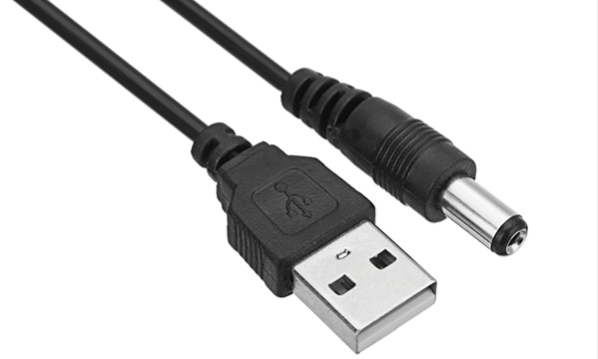Do you want to customize USB to DC Power Cable?


Sign in/up
Checkout
FAQs

DC to USB power cable is a charging cable designed for electronic devices to realize the charging function by transmitting DC power through the USB port. Its core role is to convert DC power into the voltage and current required by the device, supporting fast charging and being compatible with a variety of interface types.
> Building Mold for Your Projects
> Custom Stranded Bare Copper Wires as Needs
> UL, CE, RoHS Certified


A compact DC to USB cable conveniently uses a USB port, like power bank and wall charger, to power the low-voltage devices, such as portable fans, LED strips, and other electronics without the need for bulky power adapters. Choosing a suitable DC USB cable for your device can effectively save space and time.
To determine which USB to DC power cable fits your device, these are 3 critical factors: voltage, USB type, and plug size. Check your device power input label to figure out the required voltage and current. Then, determine the USB type for guaranteed power connection and the DC plug that matches your device.
Simply look at the shape of the USB port: USB type A is rectangular and larger, mainly used on older laptops, PCs, and power adapters; while USB type C is smaller and reversible, commonly used on modern devices like smartphones, tablets, and new laptops. Using the right match on the USB end is key to powering the device correctly.
USB A is usually used for basic 5V power supply applications, and USB C allows for higher voltages(Up to 20V) and faster with more efficient charging. Choose the suitable cable type based on your specific needs and your power source type.
The common DC barrel jack sizes cover 5.5mm x 2.1mm, 5.5mm x 2.5mm, 3.5mm x 1.35mm, and 4.0mm x 1.7mm. Among them, 5.5mm x 2.1mm size is the most prevalent one in devices, including CCTV cameras and LED lighting. Wrong DC plug size can lead to loose or failed connections if mismatched.
To figure out the DC jack size of your device, like routers(5.5mm x 2.1mm) or TV boxes(5.5mm x 2.5mm), you can check the device label, user manual, or power adapter, and you can directly ask the manufacturer. Generally, the size, voltage, and other specifications are printed near the power input port or on the adapter itself.
No. While the USB DC power cable is versatile for most consumer electronics, it can’t power any device. USB ports typically output 5 volts, which works well for low-voltage devices like small fans, LED lights, or routers. However, many devices require higher voltages and the USB DC cable is hard to achieve it.
Standard USB-A and USB-C carry 5V by default. If there is a built-in converter, the cable can carry higher voltages like 9V, 12V, or more.
Use a DC to USB power cable to connect USB to DC. Plug the USB side into the power source, like power bank, and insert the DC barrel plug into your devices.
Yes, if needed. The converter is to change the voltage coming from the socket to match the device’s requirements. USB ports typically provide a standard 5V DC output for devices, so if your device requires more than 5V, you can use a step-up voltage converter to support higher voltages like 9V or 12V.
We support customizing splitter or Y-cable for powering multiple devices. What needs to be noticed is that it may cause a voltage drop or unstable performance if the combined power exceeds what the USB port can withstand.
The USB DC power cables are widely used for various portable setups, DIY electronics, home networking, LED light strips, mini WiFi routers, CCTV cameras, and even some small 12V devices when used with a step-up converter.
Definitely. As long as the voltage and current match your device’s requirements. Checking both the power source capabilities and the device specifications to ensure a consistent and safe power connection.
To safely power a 12V router with USB power back, you may need a USB to 12V step-up converter cable because most USB power back only output 5V, which is not enough for a 12V device. Then, confirm the right DC plug that suits your router, and choose the quality USB to DC step-up cable to ensure safe and reliable powering.
Yes, you can definitely customize both the length and connector type of the USB to DC cable to meet your project needs. Vocson supports comprehensive customization services, including cable lengths(from 10cm to 2m or more), colors, AWG, connector types, or some special features like waterproof design, angled connectors, or built-in switches. Tell us your specific requirements, and our experts will give you the optimal solutions.
Fast charging usually has the following key factors. The product labeling or specifications on the cable may be marked with “Quick Charge,” “QC 3.0,” or “PD” (Power Delivery). Besides, examine the wire thickness and the wire gauge; fast charging USB DC power cables tend to use lower gauge wires like 22AWG or 24AWG to handle higher current. You can also check the current ratings like 2A and 5A, or use a USB tester or multimeter to monitor the charging current in real time. If the cable can deliver over 1.5A consistently, it is likely fast-charging
Coil the cable loosely and avoid overbending near the connectors. For longer cables, you can use cable ties or velcro straps. Keep the cable in a dry environment to avoid corrosion.
LOOKING FOR A STANDARD & CUSTOM USB to DC Power Cable SUPPLIER
FOR YOUR PROJECT
Need a Quote for USB to DC Power Cable for Your Device? Talk to Our Wire Experts Today.
@2012 - 2025 DelightFire. All Rights Reserved. | PRIVACY POLICY